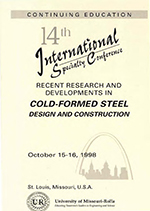Session Dates
15 Oct 1998
Abstract
The rotary expander technique can be used for manufacturing Lattice framework from a single strip of sheet metal by integrating expanded metal with solid sheet. This technique can be used to distribute the material in a tubular, or open profile to where it's best needed. Valuable qualities possible to are: - low weight and optimal strength - low energy transmission (noise and heat) - soft deformation and favorable energy absorbing properties - good fatigue resistance - high flexibility in design and product qualities These qualities are useful in applications like: - light and strong steel framing systems for buildings - energy absorbing support structures in road equipment - light vehicles - construction pipes and profiles Manufacturing of expanded metal implies a strain hardening of the mesh. This effect is more obvious in rotary expander manufacturing, due to a forced extension to match the solid metal strips. The use of strain hardened material to make light profiles with high stiffness. In combination with plaiting, it is possible to produce rigid C- and Z-studs.
Department(s)
Civil, Architectural and Environmental Engineering
Research Center/Lab(s)
Wei-Wen Yu Center for Cold-Formed Steel Structures
Meeting Name
14th International Specialty Conference on Cold-Formed Steel Structures
Publisher
University of Missouri--Rolla
Document Version
Final Version
Rights
© 1998 University of Missouri--Rolla, All rights reserved.
Document Type
Article - Conference proceedings
File Type
text
Language
English
Recommended Citation
Hellsten, M., "Technique and Qualities of Beams with Expanded Metal Sections" (1998). CCFSS Proceedings of International Specialty Conference on Cold-Formed Steel Structures (1971 - 2018). 3.
https://scholarsmine.mst.edu/isccss/14iccfsss/14iccfsss-session8/3
Technique and Qualities of Beams with Expanded Metal Sections
The rotary expander technique can be used for manufacturing Lattice framework from a single strip of sheet metal by integrating expanded metal with solid sheet. This technique can be used to distribute the material in a tubular, or open profile to where it's best needed. Valuable qualities possible to are: - low weight and optimal strength - low energy transmission (noise and heat) - soft deformation and favorable energy absorbing properties - good fatigue resistance - high flexibility in design and product qualities These qualities are useful in applications like: - light and strong steel framing systems for buildings - energy absorbing support structures in road equipment - light vehicles - construction pipes and profiles Manufacturing of expanded metal implies a strain hardening of the mesh. This effect is more obvious in rotary expander manufacturing, due to a forced extension to match the solid metal strips. The use of strain hardened material to make light profiles with high stiffness. In combination with plaiting, it is possible to produce rigid C- and Z-studs.



